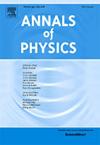螺旋石墨烯中的阻尼光子模式
IF 3
3区 物理与天体物理
Q2 PHYSICS, MULTIDISCIPLINARY
引用次数: 0
摘要
我们分析了自旋-1矢量玻色子在螺旋时空中的行为,重点研究了螺旋石墨烯结构中的光子模式。我们将螺旋石墨烯表面建模为光滑、连续和无畸变的流形,有效地采用了连续近似。通过求解全协变矢量玻色子方程,我们得到了描述弯曲螺旋背景下光子量子态的精确解,揭示了它们的能谱、模式分布和衰变动力学。我们发现,当螺旋距(a)从103纳米到1纳米变化时,阻尼光子模式的衰减时间在10−16到10−13 s之间,表明该结构有效地吸收了所有光子模式。此外,概率密度函数表现出时间依赖性,补充了它们的空间变异。这些发现为超快石墨烯光电探测器、用于高速光通信的石墨烯光电器件、先进光子器件以及用于各种纳米光子应用的基于螺旋石墨烯的量子材料的设计提供了基础。本文章由计算机程序翻译,如有差异,请以英文原文为准。
Damped photonic modes in helical graphene
We analyze the behavior of spin-1 vector bosons in helical spacetime, focusing on photonic modes in helical graphene structures. We model the helical graphene surface as a smooth, continuous, and distortion-free manifold, effectively adopting the continuum approximation. By solving the fully covariant vector boson equation, we derive exact solutions that describe the quantum states of photons in a curved helical background, revealing their energy spectra, mode profiles, and decay dynamics. We find that the decay times of damped photonic modes range from to s as the helical pitch () varies from nanometers to 1 nanometer, indicating that the structure efficiently absorbs all photonic modes. Additionally, the probability density functions exhibit time dependence, complementing their spatial variation. These findings provide a foundation for the design of ultrafast graphene photodetectors, graphene photodevices for high-speed optical communications, advanced photonic devices, and quantum materials based on helical graphene for various nanophotonic applications.
求助全文
通过发布文献求助,成功后即可免费获取论文全文。
去求助
来源期刊

Annals of Physics
物理-物理:综合
CiteScore
5.30
自引率
3.30%
发文量
211
审稿时长
47 days
期刊介绍:
Annals of Physics presents original work in all areas of basic theoretic physics research. Ideas are developed and fully explored, and thorough treatment is given to first principles and ultimate applications. Annals of Physics emphasizes clarity and intelligibility in the articles it publishes, thus making them as accessible as possible. Readers familiar with recent developments in the field are provided with sufficient detail and background to follow the arguments and understand their significance.
The Editors of the journal cover all fields of theoretical physics. Articles published in the journal are typically longer than 20 pages.
 求助内容:
求助内容: 应助结果提醒方式:
应助结果提醒方式:


